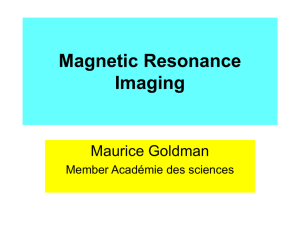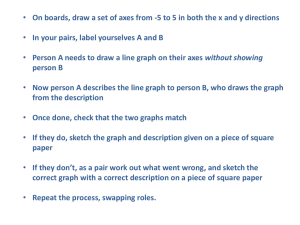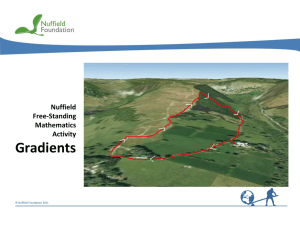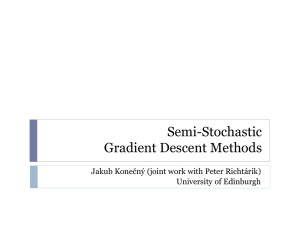Encoding and Image Formation
advertisement
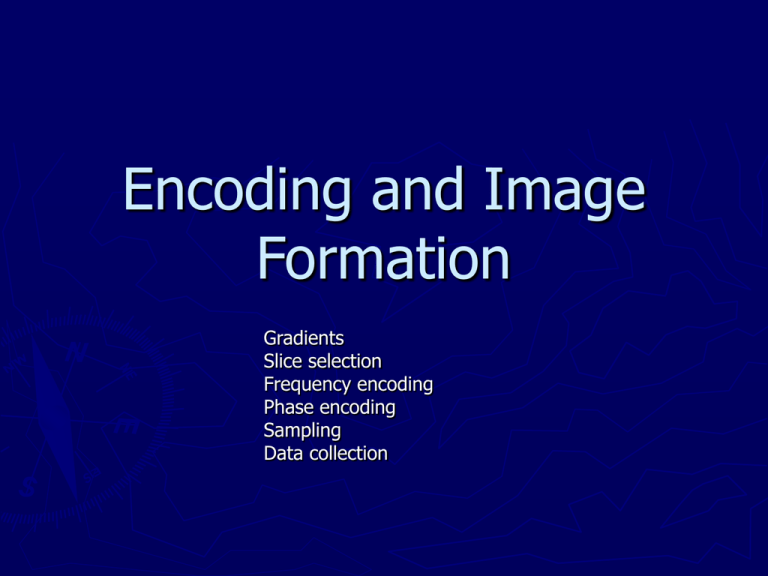
Encoding and Image Formation Gradients Slice selection Frequency encoding Phase encoding Sampling Data collection Introduction ► Encoding means the location of the MR signal and positioning it on the correct place in the image ► RF at precessional frequency of hydrogen applied at 900 to B0 resonates and flips the NMV into transverse plane. ► The individual magnetic moments of hydrogen is put into phase. ► The coherent transverse magnetization precesses at Larmor frequency in the transverse plane. ►A voltage (signal) is induced in the receiver coil placed in the transverse plane ► This signal has a frequency equal to Larmor frequency of hydrogen (at 1.5 T : 63.86 MHz) ► The system must be able to locate the signal spatially in three dimensions, so that it can position each signal at the correct point on the image. ► First it locates a slice. ► Then it is located or encoded along both axes of the image. ► This task is performed by magnetic gradients Magnetic Gradients ► Gradients are alterations to the main magnetic field and are generated by coils of wire located within the bore of the magnet. ► The passage of current through a gradient coil induces a gradient magnetic field. ► The gradient field either adds to or subtracts from B0. ► B0 is altered in a linear fashion. ► Magnetic field strength and therefore the precessional frequency of the nuclei situated in the long axis is deferent and is predictable. ► This is called spatial encoding positive negative A 2 cm 9998 G 42.5614 MHz B 10000 G 42.57 MHz 2 cm gradient 1 G per cm C 10002 G 42.5785 MHz X,Y,Z Gradient coils ► There are three gradient coils (X,Y,Z) situated within the bore of the magnet ► Z gradient alters the magnetic field strength along the Z- (long) axis ► Y gradient alters the magnetic field strength along the Y- (vertical) axis of the magnet ► X gradient alters the magnetic field strength along the X- (horizontal /transverse) axis of Y the magnet Z X ► The magnetic isocentre is the centre point of the axis of all three gradients, and the bore of the magnet. isocentre Y Z X ► The field strength remains unaltered at the isocentre Steep & shallow gradients ► ► ► ► When a gradient coil is switched on, the magnetic field strength is either subtracted from or added to B0 relative to the isocentre The slope of the resulting magnetic field is the amplitude of the magnetic field gradient and it determines the rate of change of the magnetic field strength along the gradient axis. Steep gradient slopes alter the magnetic field strength between two points more than shallow gradient slopes. Steep gradient slopes therefore alter the precessional frequency of nuclei between two points, more than shallow gradients slopes Slice selection ► This is done by first switching the appropriate gradient coil to alter the field strength and the precessional frequency at points along the corresponding axis, and then by transmitting a selected band of RF frequencies to selectively excite the nuclei which precess in that particular frequencies. ► Resonance of nuclei within the slice occurs because RF appropriate to that position is transmitted ► Nuclei situated in other slices does not resonate because their precessional frequency is different. ► Z-gradient selects axial slices ► Y gradient selects coronal slices ► X gradient selects sagittal slices Y Z X Slice thickness ► To give each slice a thickness, a band of nuclei must be excited by the excitation pulse ► The slope of the slice-select gradient determines the difference in precessional frequency between two points on the gradient. ► Once a certain gradient slope is applied, the RF pulse transmitted to excite the slice, must contain a range of frequencies to match the difference in precessional frequency between two points ► This frequency range is called the bandwidth. ► As the RF is being transmitted at this point it is called the transmit bandwidth. ► To achieve thin slices, a steep slice select slope and/or narrow bandwidth is applied ► To achieve thick slices, a shallow slice select slope and/or broad transmit bandwidth is applied. Shallow gradient slice select gradient Narrow Bandwidth Transmit bandwidth broad Bandwidth Steep gradient Thin slice Thick slice Thin slice Thick slice Gradient strength & slice thickness Shallow (weaker gradient) Steeper ( strong) gradient In Practice ► The system automatically applies the appropriate gradient slope and transmit bandwidth according to the thickness of slice required. ► The slice is excited by transmitting RF at the centre frequency corresponding to the precessional frequency of nuclei in the middle of the slice, ► The bandwidth and gradient slope determine the range of nuclei that resonate on either side of the centre. ► ► ► The gap between the slices is determined by the gradient slope and by the thickness of the slice. In spin echo pulse sequences, the slice select gradient is switched on during the application of the 900 excitation pulse and during the 1800 rephasing pulse, to excite and rephase each slice selectively. In gradient echo, the slice select gradient is switched on during the excitation pulse only. 900 Slice select gradient 1800 900 Frequency encoding ► Once a slice has been selected, the signal coming from it must be spatially located (encoded) along both axes of the image ► Locating the signal along the long axis of anatomy is done by a process called frequency encoding ► A gradient is applied along the selected axis ► The precessional frequency of signal along the axis is therefore altered in a linear fashion. ► The signal can now be located along the axis of the gradient according to its frequency A Nuclei in column A precess at frequency A B Nuclei in column B precess at frequency B C Nuclei in column C precess at frequency C For frequency encoding of ► Coronal & sagittal images – use z gradient ► Axial images – use X gradient ► Axial images of Head – use Y gradient In practice ► The frequency encoding gradient is switched on when the signal is received and is often called the readout gradient 1800 900 900 FID Echo rephasing FID dephasing Frequency peak encoding gradient The steepness of the slope of the frequency encoding gradient determines the size of the anatomy covered ; Field Of View (FOV) along the axis during scan. Phase encoding ► The location of the signal along the remaining third axis is achieved by a process called phase encoding. ► This is achieved by applying a gradient along this remaining axis ► A gradient is switched on it alters the speed of precession as well as the accumulated phase of the nuclei along their precessional path. ► It produces a phase difference or shift between nuclei positioned along the axis. Gradient & phase difference 14998 G 63.852 MHz nuclei travel slower Loose phase 15000 G 63.86 MHz 15002 G 63.868 MHz Nuclei travel faster gain phase ► When the phase encoding gradient is switched off, the magnetic field strength experienced by the nuclei returns to B0 and the precessional frequency of all the nuclei returns to the larmor frequency. ► However the phase difference between nuclei remains ► The nuclei travel at the same speed around their precessional paths, but their phases or positions are different. ► This difference in phase between the nuclei is used to determine their position along the phase encoding gradient (axis). In practice ► The phase encoding gradient is switched on just before the application of the 1800 rephasing pulse in spin echo sequences. 1800 900 Phase encoding gradient 900 Summary of phase encoding ► The phase encoding gradient alters the phase along the short axis of the anatomy Coronal images – x gradient ► In sagittal images - Y gradient ► In axial images - Y gradient ► In ► Axial images of brain – x gradient Summary spatial encoding ► The slice-select gradient is switched on during the 90 and 180 pulses in spin echo pulse sequences , and during the excitation pulse only in gradient echo pulse sequences ► The slope of the slice-select gradient determines the slice thickness and slice gap (along with transmit bandwidth) ► The phase encoding gradient is switched on just before the 180 pulse in spin echo, and between excitation and the signal collection in gradient echo. ► The slope of the phase encoding gradient determines the degree of phase shift along the phase encoding axis. ► The frequency encoding gradient is switched on during the collection of the signal ► The amplitude of the frequency encoding gradient and the phase encoding gradient determines the two dimensions of the FOV Gradient timing in spin echo TR 1800 900 slice select echo Phase encode slice select Frequency encode 900 Sampling ► The signal is collected during the frequency encoding gradient (readout gradient) ► The duration of readout gradient is called sampling time ► The system samples up to 1024 frequencies during sampling time ► The rate at which the samples are taken is called the sampling rate ► The number of samples taken determines the number of frequencies sampled ► The range of frequencies is called the receive bandwidth Frequency columns in FOV f1 f2 f3 f4 f5 f6 Receive bandwidth Frequencies sampled are mapped across the FOV along the frequency axis ► Sampling time, sampling rate and receive bandwidth are linked by a mathematical principle called the Nyquist theorem. ► It states that any signal must be sampled at least twice per cycle in order to represent or reproduced it acurately. ► In addition enough cycles must occur during the sampling time to achieve enough frequency samples ( if 256 samples are to be taken 128 cycles must occur during the sampling time) ► Number of cycles occurring per second is determined by the receive bandwidth ► Receive bandwidth is proportional to the Sampling rate ► Sampling time is inversely proportional to: The sampling rate The receive bandwidth The receive bandwidth affect the minimum TE ( because the sampling time is changed) ► Reducing the receive bandwidth increase the TE (sampling time increases) & vise versa ► Usually the receive bandwidth & sampling time are fixed Nyquist theorum Sampling once Reproduced as a straight line Sampling twice Reproduced more accurately Bandwidth versus sampling time Sampling time (8 ms) Bandwidth 16,000 Hz 128 cycles occur (256 samples can be taken) 8,000 Hz 64 cycles occur (only 128 samples can be taken) If bandwidth is reduced, the sampling time must be increased so that the same number of samples can be taken Data collection Location of individual signals within the image by measuring the number of times the magnetic moments cross the receiver coil (frequency), and their position around their precessional path (phase) 3 cycles/s Frequency shift ► 2 cycles/s 1 cycle/s Phase shift K space ► The data information is stored in the computer memory location called the K space. Maximum number of lines are 1024 frequency +ve phase One line is filled for one phase encoding gradient -ve outer central Data collection – step 1 During each TR the signal from each slice is phase encoded and frequency encoded. ► A certain value of frequency shift is obtained according to the slope of the frequency encoding gradient, which is determined by the size of the FOV. ► As the FOV remains unchanged during the scan, the frequency shift value remains the same. ► A certain value of phase shift is also obtained according to the slope of the phase encoding gradient ► The slope of the phase encoding gradient will determine which line of K space is filled with the data from that frequency and phase encoding ► Phase shift & pseudo-frequency ► The system cannot measure the phase values directly ► It can measure frequency ► The phase shift values are converted to a sine wave ► The frequency of this sine wave is called a pseudo-frequency ► Different phase shift gradient produce different sine waves with different pseudo-frequency The pseudo frequency curve time Phase shift value Phase encoding gradient & pseudo frequency ► Steeper gradients results in high pseudo frequencies ► Shallow gradients results in low frequencies ► In order to fill out different lines of K space, the slope of the phase encoding gradient must be altered after each TR ► With each phase encoding one line of K space is filled ► Different lines in K space are filled after every TR ► The phase encoding gradient is altered for every TR ► In order to complete the acquisition all the lines of selected K space must have been filled ► The number of lines that are filled is determined by the number of different phase encoding slopes that are applied K space Line 1 Line 2 Line 128 phase encode 1 frequency/phase data phase encode 2 phase encode 128 Fast Fourier Transform (FFT) data in K space is converted into an image mathematically by Fourier Transform. ► The receive signal is a composite of multiple signals with different frequencies and amplitudes ► The signal intensity/time domain is converted to a signal intensity/frequency domain RF intensity Amplitude ► The Frequency Time Time domain Frequency domain Matrix & FOV ► The FOV relates to the amount of anatomy covered ► It can be square or rectangular ► Image consists of a matrix of pixels ► Te number of pixels depends on the number of frequency samples and phase encodings ► Matrix = frequency samples x phase encodings Matrix 8 frequency samples 8 phase samples 4 phase samples 4 frequency samples Coarse matrix 4x4 Fine matrix 8 x 8 Data collection - step 2, NSA (NEX) ► When all the lines of K space is filled the acquisition is over ► But the signal can be sampled more than once with the same slope of phase encoding gradient. ► Doing so each line of K space is filled more than once ► The number of times each signal is sampled with the same slope of phase encoding gradient is usually called the number of signal averages (NSA) or the number of excitations (NEX). ► The higher the NEX, the more data is stored and the amplitude of the signal at each frequency and phase shift is greater Scan timing ► Every TR, each slice is selected, phase encoded and frequency encoded. ► The maximum number of slices that can be selected and encoded depends on the length of the TR. ► E.g. TR of 500ms may allow 12 slices. TR of 2000 ms may allow 18 slices TR & number of slices 180 90 TR echo Slice 1 TE Slice 2 Slice 3 Phase encode 1 Slice 4 Phase encode 2 Slice 1 second TR ► The phase encoding gradient slope is altered every TR and is applied to each selected slice in order to phase encode it. ► At each phase encode a different line of k space is filled. The number of phase encoding steps therefore affects the length of the scan ► E.g. 256 phase encodings require 256 x TR to complete the scan. ► The scan time is also affected by the number of times the signal is phase encoded with the same phase encoding gradient slope, or NEX . So, Scan time = TR x Number of phase encodings x NEX K space filling ► The negative half of the k space is a mirror image of the positive half. ► The polarity of the phase gradient determines whether the positive or negative half is filled ► Gradient polarity depends on the direction of the current through the gradient coil ► The central lines are filled with data produced after the application of shallow phase encoding gradients ► The outer lines are filled with data produced with steep phase encoding gradients ► The steepness of the slope of the phase encoding gradient depends on the current driven through he coil. ► The central lines of K space are usually filled first. (if 256 phase encodings are performed 128 positive lines and 128 negative lines are filled. ► The lines are usually filled sequentially either from top to bottom or from bottom to top Signal amplitude & phase shift gradient ► The shallow phase encoding gradients have smaller phase shifts. The resultant signal therefore has a large amplitude ► The steeper phase encoding gradients have larger phase shift along their axis and therefore small signal amplitudes Phase encoding slope & signal amplitude Low amplitude Steeper gradient medium gradient shallow gradient medium amplitude high amplitude Signal amplitude & frequency gradient ► The vertical axis of k space correspond to the frequency encoding ► The left of the k space is a mirror image of the right ► The centre represents the maximum signal amplitude because all the magnetic moments are in phase ► The magnetic moments on either side are either rephasing and dephasing and therefore the amplitude is less Signal amplitude & frequency gradient Peak Rephasing Dephasing K space filling & spatial resolution ► Number of phase encodings determines the number of pixels in the FOV along the phase encoding direction ► If the FOV is fixed voxels of smaller dimensions result in an image with high spatial resolution ► The steeper gradients result in high spatial resolution (two adjacent points have different phase values and can be differentiated) ► The outer lines of K space contain data with high spatial resolution ► The central lines of k space contain data with a low spatial resolution ► The central portion of k space contains data that has high signal amplitude & low spatial resolution ► The outer portion of k space contains data that has low signal amplitude and high spatial resolution Resolution & Amplitude High spatial resolution High signal High spatial resolution Way of filling K space ► The amplitude of frequency encoding gradient determines how far to the left and right K space is traversed and this in turn determines the size of the FOV in the frequency direction of the image ► The amplitude of the phase encoding gradient determines how far up and down a line of K space is filled and in turn determines the size of the FOV in the phase direction of the image (or the spatial resolution when the FOV is square) ► The polarity of each gradient defines the direction traveled through K space K space filling in gradient echo ► The frequency encoding gradient switches negatively to forcibly dephase the FID and then positively to rephase and produce a gradient echo ► Frequency encoding gradient is negative, k space traversed from left to right ► Frequency encoding gradient is positive, k space traversed from right to left ► Phase encode gradient is positive , fills top half of K space ► Phase encode gradient is negative, fills bottom half of K space K space filling in gradient echo Phase encode amplitude determines distance B Positive gradient traverse from centre through distance C Negative gradient traverse from centre through distance A Line of k space filled B A C Manipulation of K space filling ► The way in which K space is filled depends on how the data is acquired and can be manipulated to suit the circumstances of the scan; e.g. in the following Rectangular field of view Anti-aliasing Ultra fast pulse sequences Respiratory compensation Echo planar imaging Partial or fractional echo imaging ► This refers to when only part of the signal is read (sampled) during application of frequency encoding gradient ► As the sampling time is reduced minimum TE can be reduced ► This allows maximum T1 and proton density weighting and number of slices for a given TR Minimum TE Readout gradient Partial echo imaging Minimum TE reduced This extrapolated from filled segment Only this half is read Only half of the k Space is filled Partial or fractional averaging The negative and positive halves of K space on each side of the phase axis are symmetrical and mirror image of each other ► The filling of at least half of the lines is adequate to produce an image ► If 60% of lines are to be filled only 60% of phase encodings are required and the remaining lines are filled with zeros ► The scan time is there fore reduced ► E.g. 256 phase encodings and, 1 TR and ¾ NEX is selected ► This is called partial or fractional averaging ► If phase encodings = 256 TR = 1s NEX=1, Partial averaging 75% of k space is filled with data Scan time = 256 x 1 x 1 = 256 s If phase encodings = 256 TR = 1s NEX=3/4, Scan time = 256 x ¾ x 1 = 192 s 25% is filled with zeros PRE-SCAN ► This is a method of calibration that should be performed before every data acquisition. It includes; ► Finding the centre frequency on which to transmit RF. I.e. Resonant frequency of water protons within the area under examination ► Finding the exact magnitude of RF that must be transmitted to generate maximum signal in the coil. (to flip the NMV through 900) ► Adjustment of the magnitude of the received signal so that it is not too large nor too small. Reasons for failing pre-scan ► The coil is not plugged in properly ► The coil is faulty ► Chemical saturation techniques are utilized and there is an uneven distribution of fat and water in the area to be saturated ► The patient is either very large or very small Types of acquisition Sequential :– data collected for slice by slice (k- space for each slice is filled one by one) ► Two-dimensional volumetric :– data collected for all the slices simultaneously (line 1 in first slice, then line 1 in slice 2) ► Three-dimensional volumetric (volume imaging):-collect data from total volume. The excitation pulse is not slice selective, and the whole prescribed volume is excited. At the end of acquisition the volume is divided into partitions by slice select gradient which separates the slices according to their phase value along the gradient. (This is called slice encoding) ► End
